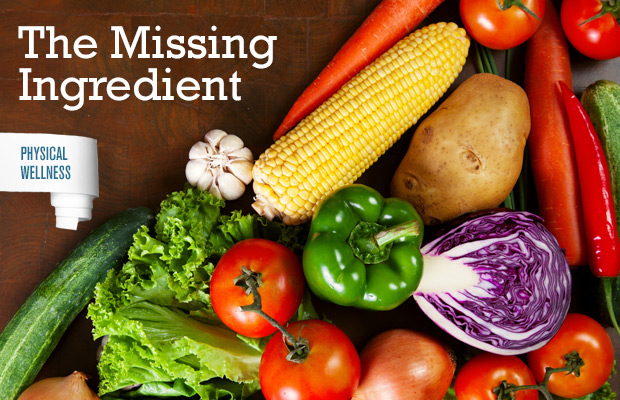The Missing Ingredient

The First Lady has her “Let’s Move” campaign. The National Football League has “Play 60.” You have that little voice in your head saying, “Something’s just not right.”
So, whether you want to be one with the crowd, or maybe you’ve decided the life of a couch potato just isn’t for you, it’s time to make some real choices and changes to your lifestyle.
You’ve joined your local gym, talked to a trainer and even consulted Saline County Lifestyles’ tips toward getting yourself in shape, but the results just aren’t what you thought they’d be. Now you’re thinking, “Hey! I made this commitment, but is it really worth it?” Well, let’s take a look:
Are you going to the gym regularly? Yes. Three to five times a week.
Are you drinking plenty of water? Yes. If I drank any more, I’d have gills.
Are you sleeping 7-8 hours a night? Well… as regularly as possible.
Are you still eating junk food? Oh… That may be a problem.
While the decision to get into shape may have been the first and the biggest step toward a new you, it’s only half of the battle toward achieving your goals. In addition to committing to a physically fit lifestyle, you must also pledge to be nutritionally fit.
To help out, we’ve got a few tips and some advice from Jennifer Jones, owner of Natural Things in Bryant.
Avoid Fad Diets
It’s certainly easy to read or hear about the latest diet craze endorsed by celebrities or one touted as “The next big thing.” However, if you’re going to discipline yourself to change, it comes with a bit of work. You may also need to compromise a little convenience in the beginning.
“It will be more time-consuming because you will probably have to prepare the food yourself,” Jones said. “Even if you’re having a salad, you’ll have to wash and chop all of those ingredients. It won’t be as easy as the drive-through Wendy’s.
“It’s going to take time, and you’re not going to lose 50 pounds overnight,” she added. “You’re not going to become Arnold Schwarzenegger in six months. This is going to be long time lifestyle change.”
Read Ingredient Labels
How can we really know what we’re eating if we don’t know exactly what we’re eating? The Food and Drug Administration (FDA) has specific guidelines requiring food manufacturers to label and display ingredients within their products.
Those labels, first enacted in 1993, must be displayed clearly for consumers to be able to examine. Commonly, you’ll find them in a white box.
In March, the FDA required manufacturers to make those boxes larger and more easily accessible and readable, and that’s exactly what Jones says you should do. “I know it sounds basic, but that is the best place to start,” she said. “You will know exactly what you’re buying and exactly what you’re picking up. It also tells you what you giving your child and what you’re putting in your body.”
Reading labels can also better educate toward certain ingredients that could be an allergen, thus harmful to your overall health. “If there’s an ingredient on there that you don’t understand or one that you might dislike or are allergic to, then you’ll know to avoid it,” Jones said.
Toss The Toxins
While pursuing a more organic approach that includes whole foods, you want to avoid processed or genetically altered goods, especially when it comes to drinks.
Avoid Artificial Sweeteners
These are most often consumed in products like diet sodas (sorry, Diet Coke is out) and many sugar-free products. The best approach is to think of them as toxins that halt your body’s metabolism because they are.
One item that could allow you some wiggle room is coffee. According to the American Journal of Clinical Nutrition, drinking an extra cup of coffee could lower your risk of adult-onset diabetes.
Otherwise, stick to the basic rule of thumb: Drink plenty of water.
Eat Whole Foods When Possible
While preparing to eat better is certainly a psychological commitment, it’s also a considerable financial commitment. Given that many whole foods are more expensive, you should invest in the time needed to find certain foods at the larger retailers while shopping for specialty items at a different location.
“There are good foods at Kroger or Walmart that aren’t expensive,” Jones said. “If you can’t afford for you and your family to all eat organic all the time, that’s understandable. I don’t know anyone who can.”
However, for certain items like meat and produce, Jones says organic alternatives are a great way to go. Toward that end, she says her store is trying to coordinate better with local farmers and meat producers. “MeatWorks does all of their meat grass fed out of Mena. They include no GMO’s, no hormones and no antibiotics.”
Splurge (In Moderation)
Most fitness experts agree that while maintaining a regimented diet of whole foods, fruits and vegetables is the way to go for optimal wellness, occasional cheating is allowed.
Some routines call for six days of strict diet six days of the week, on the seventh, you can let your hair down a bit. Maybe enjoy some pancakes for breakfast, a burger for lunch or maybe a reasonable steak for dinner.
Here’s the catch: Don’t go overboard. Moderation is the key. So make sure you don’t wreck a week’s worth of discipline and hard work by eating an entire bag of Doritos.









0 comments